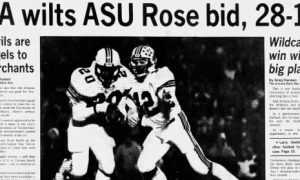
EDITOR’S NOTE: Due to the controversy surrounding Sean Miller’s technical foul in last year’s Pac-12 Tournament, an event in which former Pac-12 director of officiating Ed Rush reportedly placed a bounty on Miller to be thrown out or given a technical, this site will monitor the league’s officials during the course of the season through the conference tournament in March. The integrity of the game and its officiating was called into question by Rush’s actions, which ultimately led to his resignation.
Do you think the home arena has an effect on the officiating?
When Colorado outlasted Washington State 71-70 in overtime at Spokane, Wash., on Jan. 8, the Buffaloes attempted an incredible 38 free throws compared to only three for the Cougars.
The Buffaloes outscored Washington State 26-3 from the free-throw line in the game called by Tucsonan Chris Rastatter, Rick Batsell and Scott Brown.
You certainly can’t call Rastatter, Batsell and Brown “homers”. In fact, the way they called the game falls in line with how Colorado has been officiated in its first six Pac-12 games. Moreover, Washington State is one of the more penalized teams in the league with opponents shooting a remarkable 89 more times at the line than the Cougars.
“They were definitely attacking more than we were,” Washington State coach Ken Bone said in the postgame press conference. “We were shooting threes more than they were, so, yeah, they should have gotten to the line more than us.”
Bone then raised his eyebrows and said. “38 to 3 … that’s quite a few times.”
Because of its aggressive play under coach Tad Boyle, who brings the Buffaloes into McKale Center tonight, Colorado has a remarkable plus-77 free throws attempted in conference games compared to opponents. They lead the league in that category. They are outscoring Pac-12 opponents 121-70 from the free-throw line. They are a plus-43 in free-throw attempts on the road.

Colorado post player Josh Scott has attempted 115 free thows and made 95 for a percentage of 82.6
This site has tracked Pac-12 referees from the start of the season Jan. 2, and this week I’ve added a breakdown of calls for home and away teams.
Arizona has the third-most free-throw attempts at home this season with plus-30 compared to visitor totals, behind Stanford (38) and Colorado (34). Therefore, with Colorado’s propensity to get fouls, something has to give at McKale Center tonight. At least 60 free throws may be attempted in the game.
So which referee can be called a “homer”? Judging from the numbers, that distinction can go to Gregory Nixon and David Hall. They are two of the most used referees to this point and in games they have called, home teams are plus-30 in free-throw attempts overall.
Hall leads the most utilized Pac-12 referees with home teams having a plus-20 margin in number of fouls called. Also games in which Hall officiates, his crew averages 42 fouls and 52.4 free-throw attempts a game, both of which rank No. 2 in the conference behind Larry Spaulding (43.3 fouls and 53 free-throw attempts).
Hall has yet to officiate an Arizona game this season.
The following five charts involved a few hours of my time putting together data of league referees. I will update the data through the season. Here is a brief description of each:
Chart 1 and 2: Chart 1 indicates the referees who have officiated at least three Pac-12 games in the first four weeks of the season. Chart 2 lists all officials.
Within Chart 2, it first lists the years the referees have worked college basketball games per statsheet.com.
The conference record shown indicates the cumulative combined conference records of the teams at the time they played in the game called by the ref.
The “Rank” column is the number of games called that involve AP Top 25 teams. Also listed are stats related to games called by a referee’s crew: Personal fouls, average of personal fouls, disqualifications, technical fouls, free-throw attempts and free-throw attempt average a game.
Two new columns: PFDiff — Difference between fouls of home and away teams (a minus score reflects more calls made for the visitor), and FTDiff — Difference between free-throw attempts of home and away teams (again, a minus score reflects more calls made for the visitor).
Chart 3 and 4: Chart 3 indicates the number of overall games called by a ref of a particular conference team. Chart 4 has the same principle but indicates only certain locations where the referee called a game.
Chart 5: Indicates difference of calls made for a team at home compared to on the road in Pac-12 games. HPFDIFF stands for “Home Personal Foul Difference” compared calls to visitors. HFTDIFF stands for “Home Free Throw (attempts) compared to visitors. The same principle applies for when on the roard for APFDIFF and AFTDIFF.
CHART ONE: MOST-USED OFFICIALS
[csv src=http://wildaboutazcats.net/wp-content/uploads/2014/01/Pac12RefsMostGames53.csv]
CHART TWO: ALL OFFICIALS
[csv src=http://wildaboutazcats.net/wp-content/uploads/2014/01/Pac12RefsOverall52.csv]
CHART THREE: REFS BY TEAMS CALLED
[csv src=http://wildaboutazcats.net/wp-content/uploads/2014/01/Pac12RefsAllGames5.csv]
CHART FOUR: REFS BY LOCATIONS CALLED
[csv src=http://wildaboutazcats.net/wp-content/uploads/2014/01/Pac12RefsRoadGames5.csv]
CHART FIVE: DIFFERENCE OF CALLS HOME AND AWAY
[csv src=http://wildaboutazcats.net/wp-content/uploads/2014/01/HomeAwayPF.FtDiff.csv]
WILDABOUTAZCATS.net publisher, writer and editor Javier Morales is a former Arizona Press Club award winner. He also writes articles for Bleacher Report, Lindy’s College Sports and TucsonCitizen.com.
[rps-paypal]
|
|






















